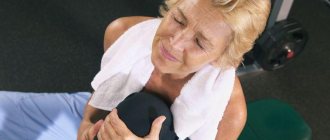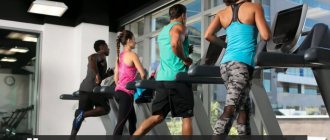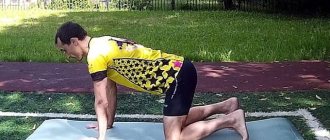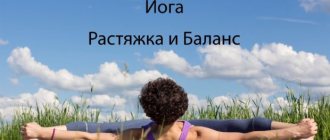How many of you pay attention to stretching? I offer a detailed analysis of why you need to stretch, when to do it, and what types of stretching exercises there are.
Author: Doug Lawrenson
Everyone knows about the benefits of stretching, but in the gym you rarely see an athlete who stretches after warming up, immediately before training.
Most lovers of strength training believe that colleagues in the shop should not see the “macho” behind stretching, and therefore avoid this type of exercise in every possible way. In doing so, they are making a big mistake, because stretching is a fundamental way to improve the health and functional fitness of an athlete.
Good stretching will make your daily life easier and prevent injury during your training sessions. Stretching should be done after warming up and before strength training. This will prepare the muscles for the upcoming loads and reduce the risk of injury.
By including a stretching routine in your training program, you will achieve:
- Reduced soreness after exercise
- Improves blood circulation
- Increasing range of motion
- Posture improvements
- Reduce muscle tension
- Reducing muscle pain
- Develop the ability to relax
So now we know the benefits of stretching, and yes, we're determined to include it in our workout routine, aren't we? Then the first step is to find out what types of stretching exercises we can do.
All stretching exercises can be divided into 7 types:
- Ballistic stretch
- Dynamic stretching
- Active stretching
- Passive stretching
- Static stretching
- Isometric stretching
- PNF stretching (proprioceptive improvement of neuromuscular transmission)
Ballistic stretch
Ballistic stretching is based on short, kicking movements that push the body, arms, and legs beyond their normal range of motion.
During this “warm-up,” you stretch using a jerking technique, and the stretched muscles act like a taut bowstring that tries to return your body to its normal position. (An example would be repetitive bending toward your toes.)
This type of stretching is not considered particularly beneficial and can lead to injury. Ballistic stretching does not allow your muscles to relax and adapt to the stretched position, but instead forces them to tighten, repeatedly activating the stretch reflex.
A few words about the stretch reflex. When a muscle is stretched, the neuromuscular spindle is also stretched. The neuromuscular spindle is a receptor that detects changes in muscle length and the rate of this change and sends a signal to the spinal cord.
The spinal cord processes the information received and activates the stretch reflex, also known as the myotatic reflex, which prevents the muscle from changing length and causes the stretched muscle to contract. And the faster the length of the muscle fiber changes, the more pronounced the response muscle contraction is.
Isometric stretching
Example of isometric stretching: “pushing the wall”
Isometric stretching is a type of stretching that involves the resistance of muscle groups caused by isometric contractions of the muscles being stretched. Examples of isometric stretching: “pushing the wall” to warm up the calf muscles, bending forward with your foot on a bar counter and trying to reach your head to your knee, and also a biceps stretch by placing your straight arm on the wall and applying force to it.
There is some evidence that isometric stretching exercises performed over a long period of time promote the development of muscle hypertrophy (increase in size). This is due to the fact that this type of stretching involves the resistance of muscle fibers.
Dynamic stretching
Dynamic stretching involves moving parts of the body and gradually increases the depth of movement, speed of movement, or both. Don't confuse dynamic stretching with ballistic stretching!
Dynamic stretching consists of controlled swinging movements of your arms and legs that (gently!) push you to the limit of your normal range of motion. And ballistic stretching exploits jerking movements that force parts of the body beyond the permissible amplitude.
There is no room for jerking or jerky movements in dynamic stretching. A good example of dynamic stretching is slow, controlled swinging of the legs or arms, and twisting of the torso.
Dynamic stretching
Dynamic stretching uses weak swings, with the help of which the body and limbs perform a full range of movements. Since during dynamic stretching the speed of exercises increases gradually, and the range of movements remains within the comfort zone, this type of stretching is most often recommended for use as a warm-up.
For golfers, boxers, martial artists and ballerinas, dynamic stretching is part of a standard intensive training complex. A 2011 study published in the European Journal of Applied Physiology found that dynamic stretching improved performance in sprinters and other intense athletes.
Program for dynamic stretching from darebee.com (clickable image)
Dynamic stretching training program
Another study, published in 2012 in the Journal of Sports Science and Medicine, compared the benefits of dynamic and static stretching for intensely training athletes. It turned out that athletes who used only dynamic stretching in their warm-up showed better results than those who performed static stretching exercises. However, the greatest increase in range of motion (ROM) was demonstrated by athletes who combined both types of stretching. This suggests that better results can be achieved by creating a mixed warm-up complex.
Static stretching
Static stretching is based on maintaining a stretching position. This means you stretch as far as you can and then hold the stretch position.
The passive stretching technique assumes that you are relaxed and are not actively trying to influence the range of motion; instead, the driving impulse comes from outside and is generated by a partner or mechanical device.
Static stretching is divided into two types: static-active stretching and static-passive stretching. In what follows, when we talk about static stretching, we will mean passive stretching.
Why do you need to stretch?
There are many benefits to regularly stretching:
- Reduces muscle stiffness and increases range of motion.
Stretching slows down joint degeneration, resulting in increased flexibility and the ability to perform daily activities with relative ease. In addition, it cannot be denied that the more flexible you are, the wider the amplitude of movements, and accordingly, the training becomes more intense. - Increases blood flow to muscles
. Doing stretching on a regular basis can improve your circulation. In turn, good blood supply increases the supply of nutrients to the muscles, helps reduce their recovery time and reduce soreness that occurs after training. - Improves posture and reduces back pain.
According to one study, combining strength training with stretching exercises can reduce musculoskeletal pain and keep the spine in proper alignment. - Relieves stress.
Combining stretching exercises with deep breathing relieves tension in the muscles and relaxes them. You may not notice it, but emotional stress causes your muscles to tense and tighten. Typical areas that may suffer from stress-related pain are the neck, upper back and shoulders. Pay enough attention to these areas.
There is no consensus among scientists regarding the reduction in the risk of injury due to stretching. This is also evidenced by a study conducted in 2001 by a scientist named Ian Shrier. It states that injuries do not occur due to lack of muscle flexibility, but due to improper exercise technique, excessive stress and an inappropriate range of motion. Stretching can reduce muscle tension, but is not a panacea for injuries.
Active stretching
Active stretching is also called static-active stretching. In active stretching, you take the desired position and then maintain it without assistance by tensing the agonist muscles.
For example, let’s take a lying leg raise with fixation at the top point without the help of improvised means, when you hold your legs in an extended position only with the help of your muscles. Tension of the agonist muscles during active stretching helps to relax the muscles that we want to stretch (antagonists) according to the principle of reciprocal inhibition.
Active stretching increases actual flexibility and strengthens agonist muscles. As a rule, it is quite difficult to maintain the position required for active stretching for longer than 10 seconds, and therefore stretching exercises rarely last more than 15 seconds.
By the way, many movements (stretches) found in various variations in yoga are examples of active stretching.
Benefits of Stretching
- Reduced muscle tension
- Expanding range of motion in joints
- helps avoid injury
- increases muscle strength
- Improved coordination of movements
- Acceleration of blood circulation in various parts of the body
- Improving the body's energy production processes
- Increasing muscle fatigue threshold and increasing endurance
- Increased efficiency in daily activities, as well as in sports and other physical activities
- Posture correction
- Mental relaxation
- Finally pleasure, a feeling of lightness throughout the body.
Passive stretching
Passive stretching is also called relaxation stretching and static-passive stretching. In passive stretching, you take the desired position and maintain it with the help of another part of your body, or with the help of a partner or improvised means. For example, lifting your leg up and holding it at the top point with your hands.
The splits are another example of passive stretching, as in this case the floor acts as a “handy tool” that helps you stay in a stretched position. Slow, relaxing stretches help to successfully combat contracture in muscles recovering from injury.
Of course, you should first consult a doctor and make sure that everything is in order, and then you can start stretching the damaged muscles. In addition, relaxation stretches are very good for “cooling down” after strength training, as they help reduce fatigue and muscle soreness after exercise.
Passive stretching
An example of passive stretching - the well-known split
Passive stretching is a form of stretching ideal for doing with a partner. In this case, it is necessary that the body remains completely passive, and all actions are performed with the application of external force (with the help of a partner). If training is carried out without a partner, body weight and gravity are used as an external force. For this reason, passive stretching is also called relaxed stretching.
An example of passive stretching is the well-known split. By spreading your legs as wide as possible and releasing your body weight on them, you allow your feet to naturally slowly slide further to the sides. Research has shown that passive stretching is ideal for muscle recovery from injury because it is done gradually and requires some time for each position.
Isometric stretching
Isometric stretching is a type of static stretching (that is, without movement) that uses counteracting the isometric contraction of the target muscle group, that is, resisting the tension of the muscle we want to stretch.
Using isometric stretching is one of the fastest ways to develop static-passive plasticity; the method is much more effective than passive stretching or active stretching alone. In addition, isometric stretching develops the strength of “tight” muscles (which helps sharpen static-active flexibility) and somewhat reduces the degree of pain that many are accustomed to associate with stretching exercises.
The easiest ways to create the resistance needed for an isometric stretch are to use resistance with your arm, a partner, or use a nearby object such as a wall or floor as a point of resistance. An example of manual counteraction would be holding the arch of the foot, preventing it from flexing while the calf muscles try to straighten the foot and pull the toes.
An example of enlisting the help of a partner to create counteraction would be for them to lift your leg up (and hold) while you try to return your leg to the ground.
An example of using a wall to generate counter force is the well-known “push the wall” exercise for stretching the calf muscles. You are trying with all your might to move the wall, although you know very well that this is impossible.
Isometric stretching is not recommended for children and adolescents who are still growing. As a rule, they are already so flexible that the strong stretch provoked by isometric contraction is accompanied by an increased risk of damage to the tendons and connective tissue structures.
Before isometric stretching, it is recommended to prepare the muscles to be stretched with dynamic strength exercises. A full set of isometric stretches places increased demands on the muscles being stretched and should not be performed more than once per day for each muscle group (ideally, no more than once every 36 hours).
The correct isometric stretching sequence is:
- Take a position for passive stretching of the target group.
- Tighten the stretched muscle for 7-15 seconds (using resistance that cannot be overcome, such as a wall or a partner).
- Relax the muscle for at least 20 seconds.
What exercises to do
Deep Lunge
Stand upside down - push your pelvis up, straighten your arms and stretch your back into one straight line. If you can't straighten your spine, bend your knees slightly and lift your heels off the floor. Rock in this position, stretching your shoulders.
Lunge forward with your right leg, place your foot next to your palm on the outside and make several springing movements. Return to the “slide”, stretch your shoulders, feel the stretch in the back of your thigh. Repeat the deep lunge with your left leg and return to the starting position.
From bending to squatting
Stand straight, place your feet shoulder-width apart. Lean forward and grab your toes. Rock, deepening the angle and feeling the stretch in the back of your thighs. Keeping your back straight, lower yourself into a deep squat, turn your knees out to the sides, and open your chest. Next - back to the starting position. Do two or three bends and straighten up.
Side lunges with body rotation
Take a shallow lunge to the right. At the same time, bend your body with a straight back, turn your chest to the right and touch your right foot with your left hand. Move your right hand back, behind your back. Try to turn your body as much as possible, and look behind your shoulder. Without straightening, move into a lunge on your left leg and touch your left foot with your right hand. Continue moving, alternating sides.
Quadriceps stretch
Stand straight with your feet together. Bend your right knee, grab your foot with your right hand and place your heel against your buttock. Straighten your left arm above your head, stretching upward. Switch legs and repeat.
Swing back and forth
Stand with your side to a wall or support. Holding on to it, swing forward and backward. Try to perform with maximum amplitude, but do not allow sudden movements, otherwise you may damage the muscles.
Swing from side to side
Stand facing a wall or support. Holding on to it, swing to the side. Bring your working leg behind your supporting leg in front to increase your swing amplitude. Aim for a full range of motion, but don't make sudden, explosive movements, which could result in injury.
Hand twists with a stick
Take a light stick or rope in your hands, place your wrists twice as wide as your shoulders. Keeping your elbows straight, lift the stick above your head and move it behind your back. Do the same in the opposite direction. Do not bend your elbows until the end of the exercise. If you can’t move the stick behind your back, grab it wider.
Tilt with body rotation
Place your feet twice as wide as your shoulders. Keeping your back and knees straight, lean forward. Turn your body to the right and touch your left foot with your right hand. Point your left hand towards the ceiling. Try to fully open your chest and turn it into the wall on your side. Without leaving the bend, repeat in the other direction.
Scorpion
Lie on the floor on your stomach, spread your arms in a cross, press your palms to the floor. Raise your right leg, bent at the knee, and try to reach your left hand. Try not to turn your body too much to the side. Return to the starting position and repeat on the other side.
Squat U-turns
Place your feet shoulder-width apart and point your toes slightly apart. Lower yourself into a deep squat, rotate your knees, and keep your back straight. Place one hand on the floor and turn your body to the side. Point your other hand towards the ceiling. Try to open your chest as much as possible while keeping your lower back arched. Switch hands and repeat on the other side.
Opening the chest in a squat
Place your feet shoulder-width apart, spread your toes to the sides, and place your hands behind your head. Lower yourself into a deep squat, turn your knees out to the sides, keep your back straight. Bend your chest as much as possible, move your elbows back, bend your lower back. Relax and then repeat.
Lunge Stretch
Stand on your left knee, push your pelvis as far forward as possible and extend your left arm up, stretching your side. Push your pelvis back, sit on your heel, straighten your right knee and pull your toes towards you. Bend over with your back straight, trying to lie with your stomach on your leg. Return to the starting position and repeat from the beginning.
Calf stretch
Find a raised area, such as a barbell plate, platform, or the edge of a machine. Stand on this equipment so that your heels remain suspended. Lower your heels as far as you can and then rise up onto your toes. Take your time and give your calf muscles a good stretch at the bottom of the exercise.
Shoulder roll
Raise your arms to the sides, pointing your palms up. Turn your shoulder inward as far as you can. Next - the starting position and repetition with the other hand.
Tilt towards the leg
Place your right foot on your heel in front of you, and pull your toe toward you. Bend your left knee, bend over with a straight back, place your right hand behind your back, and touch your left foot to the toe. Try to keep your spine straight and feel the stretch in the back of your thigh. Return to the starting position and repeat on the other leg.
Bend over with crossed legs
Place your right foot forward, crosswise with your left. Reach up with both hands. Lean forward and touch the floor next to your right foot. Straighten up and reach up again with both hands. Switch legs and repeat. Always lean towards your front leg.
Reverse plank side stretch
Sit down, place your arms behind your body, bend your knees and press your feet to the floor. Tightening your buttocks, push your pelvis up. At the same time, lift your left hand off the floor, turn your chest to the right and stretch your fingers towards the wall behind your head.
Feel your side stretch and your chest open. Tighten your buttocks so that your pelvis does not collapse. Lower yourself back to the floor and repeat on the other side.
Floor squat twists
Squat deeply, keeping your back straight, spread your knees to the sides. Turn to the right and lower both knees to the floor so that one is in front of you and the other is behind you. Lie with your stomach on your knee and stretch your arms forward. Feel the stretch in your gluteal muscle.
Raise your body and lift your legs off the floor one at a time, placing them back on your feet. If it works, return to a deep squat without using your hands; if not, rest your palms on the floor, helping yourself to rise. Do the same on the other side.
Caterpillar
Place your feet shoulder-width apart. Bend over and walk your hands along the floor until you lie down. Lower your hips to the floor and arch your back. Lower your shoulders, squeeze your shoulder blades together, stretch your neck up and look at the ceiling. Push your pelvis up, going into a lying position. Walk your hands along the floor towards your feet and straighten up. Repeat from the beginning.
Hip opening
Lie on your back, extend your arms along your body, place your feet on the floor. Squeezing your buttocks, lift your pelvis up so that your body is extended in one line. Lift your leg bent at the knee from the floor and lift it up. Move your hip to the side as if you were trying to place your shin on the floor.
Do not do it harshly under any circumstances. Move smoothly, testing the edge of your range carefully, otherwise you may damage your muscles. Bring your hip back, place your foot on the floor and, without lowering your pelvis, repeat on the other leg.
Unlike static stretching, which is often perceived as something unpleasant and painful, dynamic stretching is pure pleasure. Move smoothly, control the process and breathe deeply. And you will warm up your muscles, make your body soft and obedient, and improve your results in any sport.
PNF stretch
PNF stretching (a method of proprioceptive improvement of neuromuscular transmission, or relaxation after tension) is today considered the fastest and most effective way to increase static-passive flexibility.
In reality, this is not so much an independent type of stretching exercise, but a combined technique that combines passive stretching and isometric stretching to achieve maximum static plasticity. Initially, PNF stretching was developed as a method of rehabilitation of patients after a stroke.
PNF combines various post-isometric relaxation stretching techniques in which the muscle group is passively stretched, followed by an isometric contraction phase in a stretched position with resistance, and in the final phase the muscle is passively stretched again with an increased amplitude.
Typically, PNF stretching requires the participation of a partner who first creates resistance to the isometric contraction and then passively moves the joint through an even greater range of motion. Such exercises can be performed without outside help, but it should be recognized that with the participation of a partner they are more effective.
Most PNF stretches involve isometric agonist contraction/relaxation, in which the muscles being stretched sequentially contract and then relax.
Some PNF stretching techniques also involve contracting antagonist muscles, during which the antagonist muscles of the stretched muscles contract. In any case, it should be noted that the muscles being stretched must rest (and relax) for at least 20 seconds before performing the next PNF stretching technique. Below I will talk about the most common techniques for this type of stretching.
Grip-relax
The technique is also known as contraction-relaxation. After an initial passive stretch, the muscle being stretched contracts isometrically for 7-15 seconds, then rests briefly for 2-3 seconds and is immediately subjected to a passive stretch, which stretches the muscle more than during the initial passive stretch. The final passive stretch lasts 10-15 seconds. The muscle then rests for 20 seconds before performing the next PNF stretch.
Capture-relax-contract
The technique is also known as contraction-relaxation-contraction, and contraction-relaxation-antagonist contraction. It involves the use of two isometric contractions: first the agonist contraction, then the antagonist.
The first part is similar to the previously described grip-release technique, where after an initial passive stretch, the muscle being stretched is contracted isometrically for 7-15 seconds.
The muscle then rests while its antagonist immediately begins an isometric contraction, which is held for 7-15 seconds. Next, the muscles rest for 20 seconds before moving on to the next PNF stretching technique.
Grip-relax-swing
This technique (also called catch-release-puncture) uses dynamic or ballistic stretching in combination with static and isometric stretching.
A very risky technique that can only be successfully used by experienced athletes and dancers who have achieved an amazing degree of control over muscle stretch reflexes. It is similar to the catch-release technique, except that dynamic or ballistic stretching replaces the final phase of passive stretching.
Note that in the grip-relax-contract technique there is no passive stretching phase. It is replaced by an antagonistic contraction, which, through reciprocal inhibition, relaxes and further stretches the muscle group that was the target of the original passive stretch.
Because there is no final stretch phase, this PNF stretching technique is considered one of the safest to perform (less likely to tear muscle tissue). Many people like to make this technique even more effective by incorporating a passive stretch phase after the second isometric contraction, and while this can speed up the development of flexibility, it also increases the risk of injury.
Even more risky is dynamic or ballistic stretching integrated into PNF stretching techniques, such as grab-release-swing or grab-release-punch.
Unless you are a professional athlete or dancer, you should not even attempt these techniques (the risk of injury is too high). Even professionals should not use these techniques without the guidance of a professional trainer or experienced mentor.
These two techniques have the greatest potential for rapidly increasing flexibility, but only when performed by people who have sufficient control over the stretch reflex in the muscles being stretched.
PNF stretching is not recommended for children and people whose skeletal system continues to grow (for the same reasons). Along with isometric stretching, PNF stretching helps strengthen contracting muscles and is therefore well suited for increasing both active and passive flexibility.
And, as with isometric stretching, PNF stretching requires a tremendous amount of tension and should therefore be applied to each muscle group no more than once per day (ideally, no more than once in a 36-hour period).
The basic guidelines for PNF stretching are as follows: Perform your chosen stretching techniques 3-5 times for each muscle group, resting 20 seconds between repetitions.
And in order to reduce the duration of stretching sessions without compromising their effectiveness, it is recommended to do only one PNF stretching exercise for the target group within one training session.
When done correctly, stretching will do more than increase your flexibility. Benefits of stretching include:
- Improvement of general physical fitness
- Increased ability to master and perform exercises requiring flexibility
- Improved mental and physical relaxation
- Improving your understanding of your body
- Reduces the risk of injury to joints, muscles and tendons
- Reduced muscle soreness
- Reducing muscle contractures
- Increasing the elasticity and plasticity of connective tissue structures by stimulating the production of chemical compounds that lubricate connective tissue.
- Reducing the intensity of menstrual pain in women
Unfortunately, even a person who stretches regularly does not always do so correctly, and therefore often does not receive much of the benefits of good stretching. The most common mistakes during stretching exercises:
- improper warm-up
- insufficient rest between sets
- overextension
- poor choice of exercises
- performing exercises in the wrong (or non-optimal) sequence
How to stretch correctly
Before you rush headlong into the pool, remember the rules for stretching that will keep your muscles and joints healthy:
- Warm up your body before starting stretching exercises. “Cold” joints and muscles stretch poorly, and therefore it is very easy to get injured in the form of a sprain or tear. To “warm up”, you can choose any of the aerobic activities: running, jumping rope, exercise bike or orbitrek. If you are doing anaerobic (strength) exercises, stretch at the end of the session, as it helps to relax the muscles, and you will get worse results when lifting weights if you stretch before starting the exercises.
- Perform stretching exercises smoothly, without sudden movements and with a small amplitude (ideal - static stretching).
- Do not tense your muscles while stretching. Relaxed, they will stretch much easier.
- Don't slouch while doing stretching exercises. A slouched back, bent knees, and tense muscles make stretching ineffective.
- Breathe calmly and don't hold your breath. In the starting position, inhale through your nose, and at the moment of stretching, exhale through your mouth. If you are doing static exercises, breathe deeply on each count.
- Perform each stretch for 30-60 seconds. The stretching time depends on the flexibility of your joints and muscles, so if you find it difficult to hold your body for 1 minute, start with the maximum time possible (10-20 seconds) and gradually increase it, bringing it to the required 60 seconds.
- Do stretching exercises regularly. Starting three times a week and depending on how you feel, increase the duration and frequency of your workouts. Ideally, you should do stretching for 30-50 minutes daily (except for professional dancers, who spend 1.5-2 hours stretching per workout).
- Avoid severe pain. Stretching is a traumatic process and therefore it is better to listen to the body’s signals. If during stretching your muscles hurt a little, but you feel that it has an effect, they stretch and do not cause severe discomfort - everything is normal. If, during stretching, something crunches, rings in your ears, or begins to feel nauseous due to severe pain, immediately finish the exercise and from now on be guided by your own sensations.
- Stretch your body symmetrically. After spending 5 minutes on the right quadriceps, leave the same amount of time on the left front thigh. Only if you stretch symmetrically can you achieve benefits for your body.
Warm up before training
A standard warm-up should begin with rotations in the joints, starting from the tips of the toes and moving up, or from the fingers and going down. This simplifies joint movements due to the uniform lubrication of all articular surfaces with synovial fluid.
This lubrication helps your joints cope more easily with their functional responsibilities during the main workout. You should perform slow circular movements, both clockwise and counterclockwise, until the movement in the joint becomes completely smooth. You should work the following joints (in the suggested or reverse order):
- Fingers and metacarpophalangeal joints
- Wrists
- Elbows
- Shoulders
- Neck
- Torso and lower back
- Hip area
- Hip
- Knees
- Ankles
- Toes
By the end of the warm-up, you will have warmed up your muscles and they will become more elastic. Immediately after your general warm-up, you should perform a slow, relaxing, static stretch. Start with the back, followed by the upper body and lower body, stretching the muscles in the following sequence:
- Back
- Sides (external obliques)
- Neck
- Forearms and wrists
- Triceps
- Breast
- Buttocks
- Groin area (adductors)
- Hips (quadriceps and abductors)
- Ankles
- Shin
- Posterior thigh
- Foot
You will find exercises for static stretching of all these muscles in many books on stretching. Unfortunately, not everyone has the time to stretch all of the listed target groups before each workout.
But even if you are limited in time, be sure to find an opportunity to stretch the muscles that you plan to load during the training session.
Ballistic stretching
Ballistic stretching is a type of stretching that uses jumping and sudden movements. This form of stretching is strongly discouraged by the American Academy of Orthopedic Surgeons and is considered one of the most common causes of stretching injuries.
Ballistic stretching exercises should not be attempted without an adequate warm-up, as they push your body beyond its comfort zone. Using ballistic stretching as a warm-up is unacceptable. Ballistic stretching, after a good warm-up, is widely used by martial artists, ballet dancers and gymnasts to expand a comfortable range of motion and increase body flexibility.
Research on ballistic exercises shows that when performed after a core workout or as a stand-alone routine, they help increase range of motion and improve performance. Martial artists, gymnasts and dancers know this very well.
Finish your workout wisely
Proper completion of a workout does not come down to just stretching. This is just part of the process. Once you've completed a training session, the best way to reduce muscle fatigue and soreness (caused by lactic acid production during maximal or submaximal muscle exertion) is to return to stretching exercises. As a result, the final part of the workout will be similar to the second half of your warm-up, only in reverse order.
The final part of the training includes three phases:
- Relevant physical activity
- Dynamic stretch
- Static stretch
Ideally, you should begin the final part of your workout with 10-20 minutes of relevant physical activity, the intensity of which will be slightly higher than in the warm-up. However, in real life you may not have 20 minutes to cool down at the end of a training session, however, you should devote at least 5 minutes to a specific activity.
Relevant athletic activity should be immediately followed by stretching: first perform light dynamic stretching exercises until your heart rate returns to normal, and then move on to static stretching.
Relevant sports activity followed by stretching will relieve muscle spasms, reduce muscle tension, soreness and fatigue, and you will feel much better.
Light exercises that complete the workout, immediately following training with a maximum load, more effectively cleanse the muscles and blood of lactic acid than completely passive rest.
Moreover, if you experience muscle soreness the next day, a light warm-up can be a great way to relieve sore muscles and relieve tension, even if you don't exercise immediately after your workout.
Quite often there are sensations that indicate that you have reached the maximum level of stretching. This is indicated by symptoms such as localized warmth in the stretched muscle, followed by a burning sensation (like a cramp) and sharp pain ("dagger" pain).
Local heat usually occurs at the point of maximum permissible stretch of the muscle. When you begin to feel it, you should take a “step back” and reduce the intensity of the stretch.
If you ignore (or don't feel) this heat, you get closer to the point where a burning sensation occurs in the muscle being pulled. At this moment you should stop the exercise immediately!
You may not feel pain yet, but it will definitely come the next day. If you stretch to the point of acute pain, it is likely that the stretch has already caused damage to the muscle tissue, which causes immediate pain and does not go away for many days.
Now you know everything about stretching. And there's no reason why you should avoid it!
Stretching or stretching and flexibility exercises for beginners
Of course, the process of stretching does not actively promote weight loss, but it actually helps prepare your body for those strenuous forms of exercise (aerobic, strength or plyometric) that will allow you to quickly lose excess weight, as well as improve your range of motion and protect your joints and muscles from possible injuries.
What are the benefits of stretching for beginners?
Improves blood flow. Performing a set of stretching exercises encourages improved blood supply to all tissues of your body, including the brain. Morning exercises will help you get an extraordinary boost of energy, a high level of concentration, and also prevent fatigue and lethargy after a night's sleep. A good stretching program will involve all your vital organs, including your heart, in active work, relieving it of excess internal tension throughout the day.
Increases flexibility. Another benefit of stretching is that it significantly improves the flexibility of your entire body by increasing the range of motion of your major joints (hip, shoulder, ankle, etc.). This moment will allow you to move more freely and efficiently.
Supports a sense of balance. Lack of flexibility in one or more muscle groups can lead to muscle imbalances and, as a result, poor posture. Tight muscles negatively impact the joints, slowly creating a shift from their normal alignment. Connective tissue gradually shortens to adapt to these conditions. All this leads to a situation where the body begins to lose the ability to function at full capacity, which causes frequent injuries.
Relieves stress. Static stretching can be relaxing, both physically and mentally. Using deep and slow breathing during exercise effectively reduces the feeling of stress, one of the side effects of which is an increase in muscle tension.
Relaxes muscles. Morning stretching exercises will help make your muscles more elastic, which leads to their overall relaxation. And this is a huge plus! After all, tension in the muscles can lead to the development of discomfort, spasms and pain. And stretching allows muscle fibers to warm up and relax, which significantly reduces the risk of injury during strength training.
Prepares you for training. If you have another visit to the gym planned for today, start preparing your body from the moment you wake up. Stretching in the morning will prime your body for physical activity and help prevent muscle damage. And they, according to researchers, can greatly improve the overall level of your athletic performance.
Helps during the rehabilitation period. If you have suffered an unpleasant injury during strength training, then regular stretching sessions will help speed up your healing.
But, do not forget that this process must be gradual! That's why it's so important not to overdo it, otherwise you can cause even more harm.
Increases bone mineralization. In addition to making you physically stronger, proper stretching has additional benefits for your skeletal system. Due to the increased load on the bones, it significantly increases their mineral density, which helps prevent the development of osteoporosis and various fractures.
Promotes weight loss! And finally, stretching accelerates muscle growth and improves body composition by reducing the percentage of fat tissue
This is very important, since the opposite process occurs in the body over time, and muscle cells, as we know, due to their metabolic activity, require more energy throughout the day.










